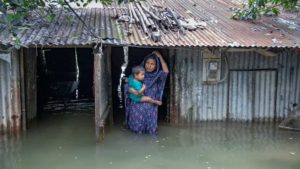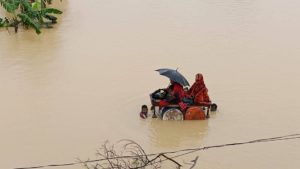Bangladesh news about horrible floods depicts the serious and dire situation of the places where the calamity has hit. Large rows of northeastern India and southeast Bangladesh have been submerged by severe floods brought on by heavy monsoon rains, leaving hundreds of thousands of people stranded and causing a major loss of life and property.
Climate change and floods have a serious link and each year it shows the evidence in different places of the world.
A high death toll has been officially reported in Bangladesh; however, officials worry the number could grow as floodwaters start to go back because of dire consequences.
Nonetheless, floods weather in Bangladesh seems more disturbing because the state has seen weeks of political turmoil. Bangladesh is also dealing with a humanitarian crisis as floods have devastated some of its most heavily inhabited areas.
The districts that have been impacted the most are Cumilla, Feni, and Noakhali, where the floods have destroyed roads, flooded entire towns and interfered with communication. As rescue efforts struggle to reach those in need, millions of people in these regions have lost access to basic essentials like food, clean water, and energy. Bangladesh floods have displaced people and put them in a state of emergency.
The key takeout of Bangladesh news about floods

Although rescue crews have been working nonstop, the tragedy’s scope is immense. To help with the evacuation attempts, volunteers from all around Bangladesh including big cities like Dhaka have flocked to the afflicted areas. However, efforts have slowed down due to logistical issues. Many families that are stuck have been waiting for days without receiving any assistance since roads are underwater and communications are broken.
The situation of floods weather is catastrophic. Since all main highways are flooded, the only way to enter the flood zone is sometimes by boat. Nonetheless, the lack of boats makes rescue operations much more difficult. Without more boats, it’s difficult to rescue as many people as we can.
Residents are in critical need of assistance. Everything is underwater due to floods weather. Over 580,000 families have been left stranded across 11 districts in Bangladesh as a result of the news of flood, according to reports, which has affected over 5 million people.
- There is an Increasing Death Toll; at least 71 deaths have been reported in Bangladesh.
- $282 million worth of crops have been destroyed in Bangladesh, while roads, bridges, and communication networks have also been devastated.
- As a result of the scarcity of clean water, there are rising worries about epidemics of diarrhea and skin illnesses.
- Moreover, the severity of the recent Bangladesh flood and India is an instance of how climate change is increasingly affecting global weather patterns.
Climate scientists claim the relation between Climate change and floods; is that greater monsoon rainfall is correlated with rising global temperatures, increasing the frequency and severity of floods. Due to its physical location on low-lying delta plains where rivers meet the sea, Bangladesh is particularly vulnerable. Additionally, as a result of climate change, the Himalayan glaciers are melting more quickly, which has increased river flooding and caused floods in Bangladesh and India.

Disease Transmission is another dire and threatening aspect to be noted in Bangladesh news. Due to lethargic floodwaters, the floods have caused an alarming rise in waterborne infections. Because there is a severe shortage of medical supplies and safe drinking water, diseases including cholera, diarrhea, skin infections, and respiratory disorders are spreading quickly.
The health crisis is beyond the capacity of the medical infrastructure in Bangladesh flood, and temporary shelters lack the necessary resources to handle it. Furthermore, the frequency of snake bites is increasing, which worsens the impact on the impacted communities.

Bangladesh news of flooding highlights Millions of lives are at risk, thus the priorities must be on averting future water disputes, rebuilding with climate adaptation in mind, and protecting the health and safety of impacted populations.













